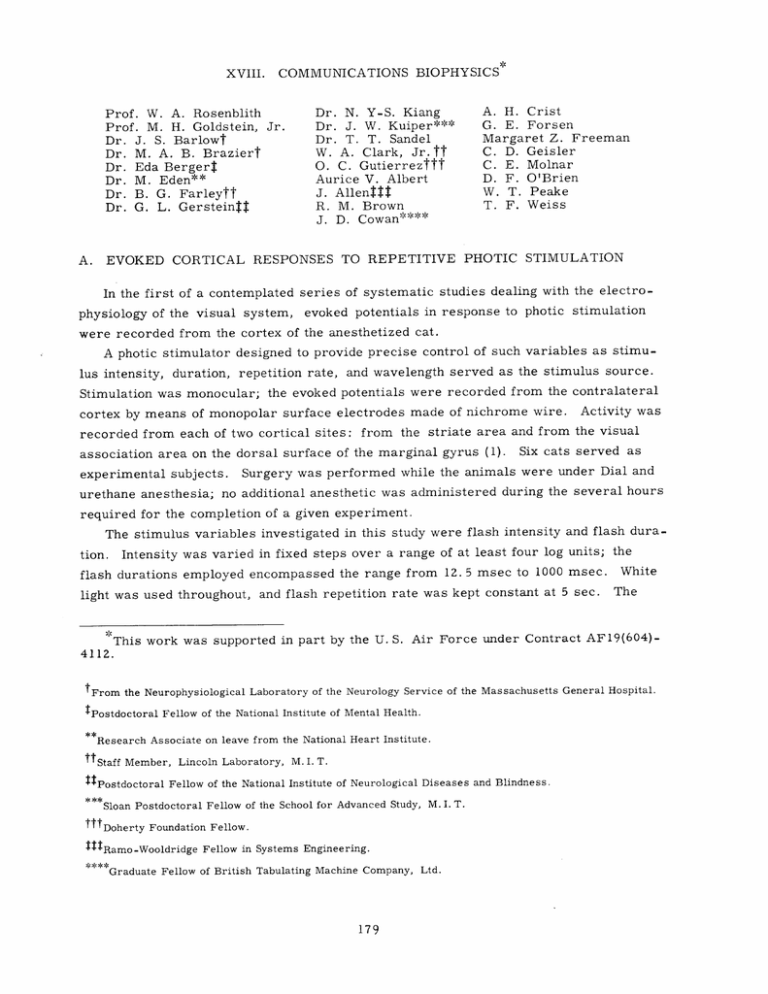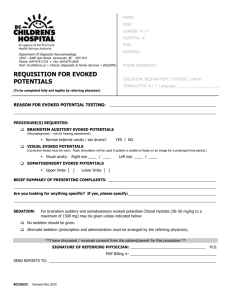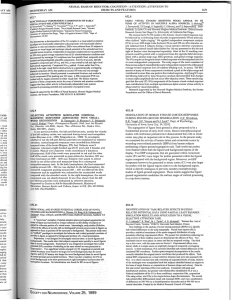XVIII. COMMUNICATIONS BIOPHYSICS
advertisement

XVIII. COMMUNICATIONS BIOPHYSICS Prof. W. A. Rosenblith Prof. M. H. Goldstein, Jr. Dr. J. S. Barlowt Dr. M. A. B. Braziert Dr. Eda Berger$ Dr. M. Eden** Dr. B. G. Farleytt Dr. G. L. Gersteinj$ A. Dr. N. Y-S. Kiang Dr. J. W. Kuiper**' Dr. T. T. Sandel W. A. Clark, Jr. tt O. C. Gutierrezttt Aurice V. Albert J. Allen$$$ R. M. Brown J. D. Cowan**** EVOKED CORTICAL RESPONSES TO REPETITIVE * A. H. Crist G. E. Forsen Margaret Z. Freeman C. D. Geisler C. E. Molnar D. F. O'Brien W. T. Peake T. F. Weiss PHOTIC STIMULATION In the first of a contemplated series of systematic studies dealing with the electrophysiology of the visual system, evoked potentials in response to photic stimulation were recorded from the cortex of the anesthetized cat. A photic stimulator designed to provide precise control of such variables as stimulus intensity, duration, repetition rate, and wavelength served as the stimulus source. Stimulation was monocular; the evoked potentials were recorded from the contralateral cortex by means of monopolar surface electrodes made of nichrome wire. Activity was recorded from each of two cortical sites: from the striate area and from the visual Six cats served as association area on the dorsal surface of the marginal gyrus (1). experimental subjects. Surgery was performed while the animals were under Dial and urethane anesthesia; no additional anesthetic was administered during the several hours required for the completion of a given experiment. The stimulus variables investigated in this study were flash intensity and flash duraIntensity was varied in fixed steps over a range of at least four log units; the flash durations employed encompassed the range from 12. 5 msec to 1000 msec. White light was used throughout, and flash repetition rate was kept constant at 5 sec. The tion. -, This work was supported in part by the U. S. Air Force under Contract AF19(604)- 4112. tFrom the Neurophysiological Laboratory of the Neurology Service of the Massachusetts General Hospital. T Postdoctoral Fellow of the National Institute of Mental Health. **Research Associate on leave from the National Heart Institute. tStaff Member, "Postdoctoral Lincoln Laboratory, M. I. T. Fellow of the National Institute of Neurological Diseases and Blindness. Sloan Postdoctoral Fellow of the School for Advanced Study, M. I. T. ttDoherty Foundation Fellow. tlRamo-Wooldridge Fellow in Systems Engineering. ****Graduate Fellow of British Tabulating Machine Company, Ltd. 179 (XVIII. COMMUNICATIONS BIOPHYSICS) animal was kept in a dark anechoic chamber, and adequate precautions were taken to ensure a constant state of dark adaptation prior to each experimental series. For each intensity-time combination of the stimulus, evoked potentials were recorded continuously for a six-minute period. These responses were subsequently processed by means of the ARC-1 computer (2) to yield a composite averaged response. The evoked cortical potentials recorded in this fashion exhibit the following features: There is an "early" response that appears to be related to the onset of the photic stimulus, as well as a "late" response that seems to be related to the cessation of stimulation. Accordingly, over the range of values investigated, the early response, in its simplest form, seems to be independent of flash duration, whereas the time of occurrence of the late response is governed by flash duration. (See Fig. XVIII-1.) Both the early and the late responses undergo characteristic changes as a function of stimulus intensity. Their latencies (i. e., the elapsed time between the onset of the stimulus and the first measurable deflection of the evoked potential) vary inversely with the intensity of the flash. The time of occurrence of characteristic maxima and/or minima in the waveforms of both of these responses shows a similar dependence on stimulus intensity. (See Fig. XVIII-2.) Variations in flash intensity result in another type of modification of the early response, namely, the emergence of a secondary component at higher intensities. pared with the initial event of the early response, Com- this secondary component seems more complex and variable, in that its elicitation is more critically dependent upon appropriate intensity-time relations of the stimulus. Thus, although there is no evidence for a secondary component of the early response at low levels of stimulation, itself at high flash intensities. it does manifest At intermediate intensity levels, where the secondary component first emerges, it seems to interact with the late response; the nature of this interaction is unpredictable and typically distorts the time sequence among the various components of the total response pattern. it can be identified, 200 msec) is Consequently, Furthermore, even at high intensities where the latency of this secondary component (approximately 100 to such that it may effectively block the appearance with stimuli whose duration is of the late response. less than approximately 200 msec, the complete response pattern in all its details may not emerge. flash duration is However, when sufficiently long and intensity sufficiently high that interaction (see Fig. XVIII-3) among various response components is minimized or eliminated, the total response pattern can be seen. (See Fig. XVIII-4.) The rate of stimulus presentation also seems to affect the evoked cortical potentials, most notably their amplitude. (See Fig. XVIII-5.) Precise quantitative evaluation of various features of evoked cortical potentials obtained under these conditions is complicated by our inability to specify the depth of anesthesia of the animal at the time when a given response sample is being recorded. 180 Li LJ ------ r-- 100 .~V 100 MSEC Fig. XVIII-1. Evoked cortical potentials from visual association area to low-intensity photic stimuli. Each tracing represents the average of 70 consecutive responses. Flash durations: 12. 5, 25, 50, 100, and 200 msec. (Cat Sh.). HIGH INTENSITY 100 Pv 100 MSEC I. Fig. XVIII-2. J Evoked cortical potentials from visual association area to a 100-msec flash at 2 intensity levels, 4 log units apart. Each record is the averaged response to 70 consecutive flashes. (Cat Reu.). 181 LOW INTENSITY MEDIUM INTENSITY HIGH INTENSITY 100v 100 MSEC Fig. XVIII-3. Evoked cortical potentials from visual association area to a 200-msec flash at 3 intensity levels, separated by 2 log unit steps. Averaged response to 70 consecutive flashes. (Cat Reu.). A A B C 0 MSEC 100 MSEC 1000 Fig. XVIII-4. 2000 Evoked cortical potentials from visual association area to a high intensity flash. Averaged response to 64 consecutive flashes. Flash durations: 100, 200, 500, and 1000 msec. Last two traces refer to the 1000-msec stimulus and cover a total time period of 2000 msec to show late response following cessation of stimulus. A and B, primary and secondary component of the early response; C, late response. (Cat Go.). 182 TIME AFTER ANESTHESIA 2 HR 30 MIN I I 3 HR REPETITION RATE r 5 HR I ISE 5 SEC _jr 7 HR 35 MIN 30 SECOOv 100 100 Fig. XVIII-5. 100 MSEC MSEC Evoked cortical potentials from visual association area to a 100-msec flash of low intensity. Averaged response to 70 consecutive flashes. Elapsed time between consecutive stimulus presentations: 1, 5, and 30 sec. (Cat Sh.). /v Fig. XVIII-6. Evoked cortical potentials from visual association area to a 100-msec flash of low intensity at various times following administration of Dial and urethane anesthesia. Averaged response to 70 consecutive flashes. (Cat Sh.). (XVIII. COMMUNICATIONS BIOPHYSICS) TIME AFTER ANESTHESIA 2 HR 50 MIN 4 HR 16 MIN 5 HR 31 MIN 7 HR 5 MIN 8 HR 25 MIN 100 /v 100 Fig. XVIII-7. MSEC Evoked cortical potentials from visual association area to a 100-msec flash of low intensity at various times following administration of Dial and urethane anesthesia. Averaged response to 70 consecutive flashes. (Cat Es.). In an attempt to gauge the effects produced by this variable, each of our animals was exposed to a uniform stimulus situation at various times following the last injection of Dial. A 100-msec flash at each of two intensity values was employed for this purpose. The averaged responses to these test stimuli fail to reveal any consistent trend. some animals there is a progressive reduction in response latency, For as well as an increase in response amplitude as a function of elapsed time following administration of. Dial (Fig. XVIII-6), but others manifest no consistent changes over similar time periods. Still others show first a decrease in response amplitude, (Fig. XVIII-7). followed by an increase These factors must be taken into consideration for each particular animal in evaluating response parameters of evoked cortical potentials. O. C. Gutierrez, Eda Berger References 1. R. W. Doty, Potentials evoked in cat cerebral cortex by diffuse and by punctiform photic stimuli, J. Neurophysiol. 21, 437-464 (1958). 2. W. A. Clark, Jr., Average response computer (ARC-I), Quarterly Progress Report, Research Laboratory of Electronics, M. I. T., April 15, 1958, p. 114. B. ELECTRICAL RESPONSES TO ACOUSTIC CLICKS IN MONKEYS During a study of potentials evoked by acoustic clicks in human subjects (1), it was observed that the responses recorded from scalp electrodes were not localized over the 184 ELECTRODE 2 2 ,L-- (b) (a) S /IV 5 ' Fig. XVIII-8. ---- MSE 50 MSEC -i Mean responses recorded from an intact monkey. 900 clicks, approximately 30 db above visually detectable threshold were presented at Monopolar recordings; negativity is plotted a rate of 10 per second. Solder-blob electrodes on the scalp were used to record (a); upward. needle electrodes on the skull were used (skin intact) in (b). Dial anesthesia. 100 MSEC Fig. XVIII-9. Mean responses recorded from exposed pia. 900 clicks 20 db above threshold were presented at a rate of 5 per second. Monopolar recordings; negativity is plotted upward. SF stands for sylvian fissure; STS, superior temporal sulcus; SS, simian sulcus; C, central sulcus; IPS, inferior postcentral sulcus. Dial anesthesia. 185 (XVIII. COMMUNICATIONS BIOPHYSICS) temporal regions. tions. Rather, responses were obtained from widespread electrode loca- The intervening layers of dura, skull, and scalp would be expected to have some effect upon the spread of these cortical potentials, yet potentials evoked from cortex lying directly beneath the skull (sensorimotor cortex) have been obtained from welllocalized regions on the human scalp (2). The human auditory cortex, however, is known to lie within the sylvian fissure and its greater distance from the skull may account for the widespread responses to auditory stimuli. A study of the problem of localization of electric potentials evoked by acoustic clicks was undertaken. Cynomolgus monkeys were used because their auditory cortex lies within the sylvian fissure. Observations were limited to two monkeys. generated by 0. l-msec electric pulses delivered to a PDR-10 earphone, to the anesthetized monkeys, scalp and the cortex. Auditory clicks, were presented and responses were recorded at various levels between the Both monopolar and bipolar recordings were made; in the first instance, electrodes imbedded in the cheek bones served as indifferent electrodes. Since the evoked potentials were too small to be visually detectable in the background activity, the average response computer (3) was used. The curves shown represent the average of responses (or mean response) to 900 consecutive click presentations. Figure XVIII-8 shows responses recorded monopolarly from the intact head. The mean responses shown in Fig. XVIII-8a were recorded from the shaven surface of a monkey's scalp with small solder-blob electrodes similar to those used on human subjects. Notice that although responses are seen, they were obtained from such widely separated locations as those situated over the temporal and occipital regions. However, when needle electrodes (insulated, except at the tip) are driven into the skull at these same spots, the responses recorded from the temporal electrode increase considerably in amplitude (Fig. XVIII-8b), while responses from other electrodes show little change. Figure XVIII-9 shows monopolarly recorded responses from the pial surface of the exposed cortex. As previously reported by Pribram, Rosner, rhesus and mangabey monkeys, and Rosenblith (4) for responses were obtained from widespread locations. Mean responses were obtained from all points tested, although waveshape and magnitude are quite variable. the sylvian fissure. Notice the large well-localized response at point 2, just rostral to In this particular experiment, recordings were also made at the various levels encountered as the cortex was being exposed. Responses obtained from dural electrodes directly above the numbered points on the pia closely resemble, in waveform and magnitude, the responses obtained from the pia, except at point 2, where the response amplitude dropped from 5 pv to 1 Lv. Responses were also obtained from the skull (scalp intact) directly above these same five points, and showed little change in waveshape, although they were only about half as great in magnitude as those recorded from the dura. When the scalp was removed, responses obtained from skull electrodes closely matched those recorded from the corresponding dural electrodes. 186 (XVIII. Finally, COMMUNICATIONS BIOPHYSICS) responses were recorded from the exposed auditory cortex, resection of the superior temporal gyrus. after subpial Responses of the same shape as those recorded from point 2 in Fig. XVIII-9 were obtained, but the amplitudes ranged from 50 4v to 70 .Lv. These data show that although 70-Lv responses were recorded from the monkey's exposed auditory cortex, responses recorded from the surface of the intact cortex were, at most, 5 4v in amplitude. The attenuating effect of dura and scalp is such that responses obtained from solder electrodes on the intact scalp record widespread The shunting effects of the dura and scalp, responses of approximately 1 4v. presumably good conductors, are striking. both At both of these layers, when well-localized responses were recorded from points beneath them, greatly reduced responses were recorded from the corresponding points above them. Poorly localized responses, on the other hand, are almost unaffected. Clearly, some sort of spatial averaging is taking place. Although these conclusions are not directly applicable to human subjects, certainly human dura and scalp will produce similar attenuation of cortical responses. since human auditory cortex is also within the sylvian fissure, And responses recorded from the surface of the cortex and from the scalp may be expected to be small and widespread. C. D. Geisler References 1. C. D. Geisler, L. S. Frishkopf, and R. M. Brown, The "early" response to clicks in awake subjects, Quarterly Progress Report, Research Laboratory of Electronics, M.I.T., July 15, 1957, pp. 144-148. 2. G. D. Dawson, Cerebral responses to electrical stimulation of peripheral nerve in man, J. Neurol. Neurosurg. Psychiat. 10, 134-140 (1947). 3. W. A. Clark, Jr., Average response computer (ARC-1), Report, Research Laboratory of Electronics, M. I. T., April 15, Quarterly Progress 1958, pp. 114-117. 4. K. H. Pribram, B. S. Rosner, and W. A. Rosenblith, Electrical response to 17, Neurophysiol. acoustic clicks in monkey: extent of neocortex activated, J. 336-344 (1954). 187




